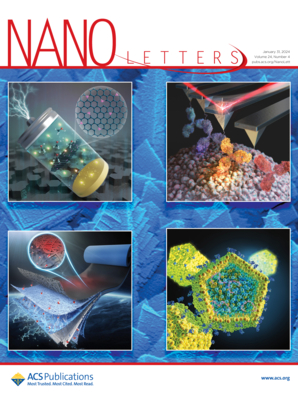具有双重防护机制的防污PTFE中空纤维微滤膜
IF 9.6
1区 材料科学
Q1 CHEMISTRY, MULTIDISCIPLINARY
引用次数: 0
摘要
聚四氟乙烯(PTFE)是高污染废水处理的首选材料。对聚四氟乙烯中空纤维膜进行亲水性改性,可进一步提高其过滤性能和耐久性。然而,在聚四氟乙烯表面构建坚固的亲水性涂层仍然是一个挑战。本文报道了一种用聚乙烯醇(PVA)和多离子络合物(PIC)双层水凝胶原位涂覆聚四氟乙烯中空纤维膜的表面工程策略。第一层PVA水凝胶层通过戊二醛(GA)诱导的席夫碱反应和醛醇缩合分别与N-β-(氨基乙基)-γ-氨基丙基三甲氧基硅烷(AEAPTS)接枝的聚四氟乙烯共价结合,第二层PIC水凝胶层通过氢键和拓扑纠缠牢固地固定在PVA上。所制得的PVA/PIC DL水凝胶涂层具有良好的强度和耐化学性。此外,水合层和多两性离子刷的双重防御机制使膜具有持久的微滤和防污性能,可以有效地排斥各种污染物。本文章由计算机程序翻译,如有差异,请以英文原文为准。

Antifouling PTFE Hollow Fiber Microfiltration Membrane with a Double-Defense Mechanism
Polytetrafluorethylene (PTFE) is the preferred material for highly polluted wastewater treatment. Hydrophilic modification of the PTFE hollow fiber membrane can further enhance its filtration performance and durability. Yet, it still remains a challenge to construct a robust hydrophilic coating on the PTFE surface. Here we report a surface engineering strategy of in situ coating a PTFE hollow fiber membrane with poly(vinyl alcohol) (PVA) and polyion complex (PIC) double-layer (DL) hydrogels. The first PVA hydrogel layer was covalently bonded to N-β-(aminoethyl)-γ-aminopropyl trimethoxysilane (AEAPTS)-grafted PTFE via a glutaraldehyde (GA)-induced Schiff base reaction and aldol condensation, respectively, while the second PIC hydrogel layer was strongly anchored on PVA through hydrogen bonding and topological entanglements. The resulting PVA/PIC DL hydrogel coating exhibited favorable strength and chemical resistance. Moreover, the double-defense mechanism provided by the hydration layer and polyzwitterionic brushes endowed the membrane with durable microfiltration and antifouling performances by effectively repelling various types of pollutants.
求助全文
通过发布文献求助,成功后即可免费获取论文全文。
去求助
来源期刊

Nano Letters
工程技术-材料科学:综合
CiteScore
16.80
自引率
2.80%
发文量
1182
审稿时长
1.4 months
期刊介绍:
Nano Letters serves as a dynamic platform for promptly disseminating original results in fundamental, applied, and emerging research across all facets of nanoscience and nanotechnology. A pivotal criterion for inclusion within Nano Letters is the convergence of at least two different areas or disciplines, ensuring a rich interdisciplinary scope. The journal is dedicated to fostering exploration in diverse areas, including:
- Experimental and theoretical findings on physical, chemical, and biological phenomena at the nanoscale
- Synthesis, characterization, and processing of organic, inorganic, polymer, and hybrid nanomaterials through physical, chemical, and biological methodologies
- Modeling and simulation of synthetic, assembly, and interaction processes
- Realization of integrated nanostructures and nano-engineered devices exhibiting advanced performance
- Applications of nanoscale materials in living and environmental systems
Nano Letters is committed to advancing and showcasing groundbreaking research that intersects various domains, fostering innovation and collaboration in the ever-evolving field of nanoscience and nanotechnology.
 求助内容:
求助内容: 应助结果提醒方式:
应助结果提醒方式:


